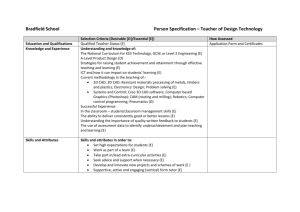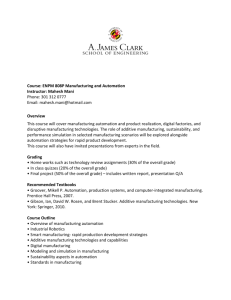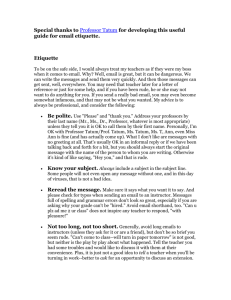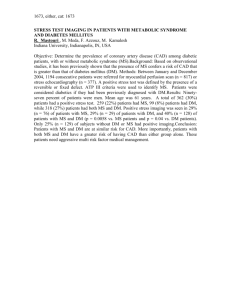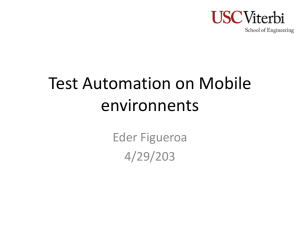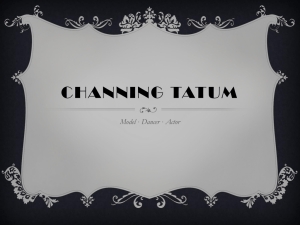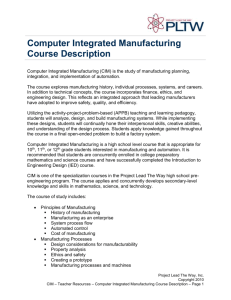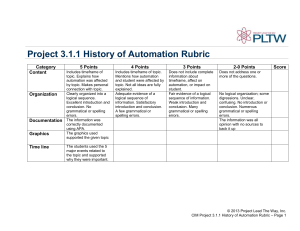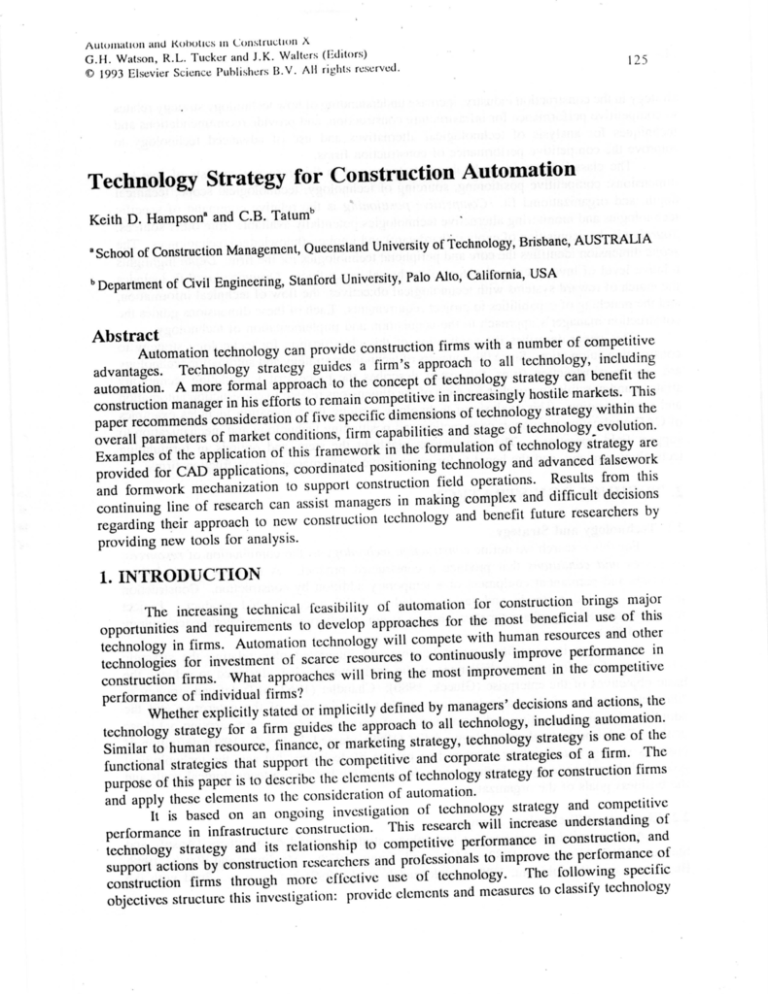
AutumaUun and Kotxolies ut ^onstruet on X
G.il. Watson, R.L. Tucker and J.K. Walters (Editors)
125
G 1993 Elsevier Science Publishers B.V. All rights reserved.
Technology Strategy for Construction Automation
Keith D . Hampsone and C.B. Tatumb
School of Construction Management, Queensland University of Technology
b Department
, Brisbane , AUSTRALIA
of Civil Engineering, Stanford University, Palo Alto, California, USA
Abstract
Automation technology can provide construction firms with a number of competitive
advantages. Technology strategy guides a firm's approach to all technology, including
. A more formal approach to the concept of technology strategy can benefit the
automation
his efforts to remain competitive in increasingly hostile markets. This
construction manager in
paper recommends consideration of five specific dimensions of technology strategy within the
overall parameters of market conditions, firm capabilities and stage of technology. evolution.
Examples of the application of this framework in the formulation of technology strategy are
provided for CAD applications, coordinated positioning technology and advanced falsework
and formwork mechanization to support construction field operations. Results from this
continuing line of research can assist managers in making complex and difficult decisions
regarding their approach to new construction technology and benefit future researchers by
providing new tools for analysis.
1. INTRODUCTION
The increasing technical feasibility of automation for construction brings major
opportunities and requirements to develop approaches for the most beneficial use of this
technology in firms. Automation technology will compete with human resources and other
technologies for investment of scarce resources to continuously improve performance in
construction firms. What approaches will bring the most improvement in the competitive
performance of individual firms?
Whether explicitly stated or implicitly defined by managers' decisions and actions, the
technology strategy for a firm guides the approach to all technology, including automation.
Similar to human resource, finance, or marketing strategy, technology strategy is one of the
functional strategies that support the competitive and corporate strategies of a firm. The
purpose of this paper is to describe the elements of technology strategy for construction firms
and apply these elements to the consideration of automation.
It is based on an ongoing investigation of technology strategy and competitive
performance in infrastructure construction. This research will increase understanding of
technology strategy and its relationship to competitive performance in construction, and
support actions by construction researchers and professionals to improve the performance of
construction firms through more effective use of technology. The following specific
objectives structure this investigation: provide elements and measures to classify technology
126
strategy in the construction industry, increase understanding of how technology strategy relates
to competitive performance for infrastructure construction, and provide recommendations and
techniques for analysis of technological alternatives and use of advanced technology to
improve the competitive performance of construction firms.
The classification for technology strategy used in this research consists of five key
dimensions: competitive positioning, sourcing of technology, technological scope, technical
depth, and organizational fit. Competitive positioning is the relative command of specific
technologies and monitoring alternative technologies potentially available from other sources.
Sourcing is the acquisition of explicit (hardware) and implicit (knowledge) technologies. The
highlights
scope dimension identifies the core and peripheral technologies for the firm. Depth
relative level of investment and extent of technical capabilities. Organizational fit includes
the match of reward systems with technological objectives, the flow of technical information,
and the matching of capabilities to project requirements. Each of these dimensions guides the
construction manager's approach to the acquisition and implementation of technology.
This paper describes the application of this classification for technology strategy to
construction automation. Since the concepts of technology strategy and automation technology
are new to construction firms, this paper describes the process of formulating technology
strategy and possible approaches for each of the dimensions related to construction automation
and mechanization. This analysis of technology strategy for automation includes examples
of CAD application to support construction and positioning technology and mechanization to
support field operations. The conclusions highlight the steps and options in formulating
technology strategy, and the benefits for competitive performance of construction firms.
2. TECHNOLOGY STRATEGY
2.1. Technology and Strategy
For this research we define construction technology as the combination of resources,
processes and conditions that produce a constructed product. A resource can be either
materials and permanent equipment or a temporary addition by construction. Construction
processes are the methods and tasks needed to build a constructed product. Project
requirements and site characteristics are the major conditions of construction technology
(Tatum, 1988).
A strategy is a unified, comprehensive and integrated plan relating the strategic
advantages of the firm to the challenges of the environment. It is designed to achieve the
basic objectives of the enterprise (Glueck, 1980). Chandler (1962, p13) defined strategy as
"the determination of the basic long-term goals and objectives of the enterprise and the
adoption of courses of action and the allocation of resources necessary for carrying out these
goals". To define technology strategy, Adler (1989) adapted Andrew's (1980) definition of
business strategy: technology strategy is a pattern of decisions that sets the technological
goals and the principle technological means for achieving both those technological goals and
the business goals of the organization.
2.2. Elements of Technology Strategy
A range of determinants for technology strategy provided by others (Ansoff and
Stewart, 1967; Freeman, 1982; Miles and Snow, 1978; Maidique and Patch, 1988;
Burgelman and Rosenbloom, 1989; Malekzadeh et al, 1989) has been reviewed with the
objective of selecting one set of parameters that ensures conceptual completeness, but avoids
unnecessary duplication. The following technology strategy dimensions synthesizes the
background:
o competitive positioning refers to the role that technology plays in establishing generic
competitive advantage or how product technology, process technology and technical
support capabilities are used to achieve cost leadership or differentiation (Porter, 1985).
Maidique and Patch (1988, p241) raise the managerial question of "what new
technologies to add to the firm's core set of technological skills?" Three factors that
guide strategy in an important technology are: sustainability of the technology lead,
first-mover advantages, and first-mover disadvantages (Porter, 1985).
o sourcing of technology incorporates the dual (but overlapping) concepts of Burgelman
and Rosenbloom's "Technology and the Value Chain" and the Malekzadeh et al
"Sources of Technological Capability". To remain competitive a firm must structure
ways to acquire certain value-creating technologies, i.e.. the develop or buy argument.
This decision to acquire new technology is, as described by Rosenberg et al (1990,
p22), "inescapably an investment decision".
o scope of technology strategy describes the set of product and process technologies in
which the business unit has invested combined with an assessment of the maturity of
the technologies (Malekzadeh et al, 1989). No firm can hope to operate on the
frontiers of all technologies relevant to its operations. The set of technologies that can
have a material impact on its competitive advantage are core technology; all others are
peripheral. Of course in a dynamic world, peripheral technologies can become
tomorrow's core technologies and vice versa (Burgelman and Rosenbloom, 1989).
o depth of technology strategy encompasses the number of technological options the
firm has available. The depth of a firm's technology strategy is determined to a
significant extent by the intensity of its resource expenditures. Investment in
technological resources is positively related to technical output (Mansfield, 1981).
Expenditure on internal R&D has a strong relationship to increased profitability (Capon
et al, 1990).
0 organizational fit encompasses administrative and cultural factors of the firm. Patterns
of technical communication throughout the construction organization are important
determinants to the quality of organizational fit. From the Burgelman and Rosenbloom
(1989) evolutionary point of view, organizational context serves as an internal selection
mechanism affecting the strategic management of the firm. Burgelman and Sayles
(1986) work suggests that reward systems may provide potential measures of one
aspect of the organizational context of technology strategy.
2.3. Link Between Technology Strategy and Performance
The background literature contains examples of relationships between technologyrelated inputs and competitive performance. The Miles and Snow (1978) typologies include
a technology-based component. The four basic patterns of strategy that emerged however, are
principally based on a descriptive analysis of how an organization changes its products or
markets. While each of these cases is of interest in their own right, no linkages are apparent
corresponding to the recently unified concept of technology strategy which comprises a diverse
range of inputs and competitive performance.
128
3. FORMULATING TECHNOLOGY S71 RATEGY FOR AUTOMATION
Selecting a firm's approach to a specific technology requires consideration of each
clement: positioning, sourcing, scope, depth, and organizational fit. This section describes
a process of formulating technology strategy, primarily using examples of CAD applications
in construction, coordinate positioning technology and highly mechanized falsework/formwork
systems. By considering each of the elements for several candidate technologies, managers
can formulate a technology strategy that best fits the capabilities and culture of a firm and
creates substantial competitive advantages.
3.1. Competitive Positioning
Automation technology can provide several types of competitive advantages. Examples
include: offering new products in new markets, developing distinctive or unique competence,
serving a niche market, reducing project durations, and decreasing life cycle cost (Tatum,
1989a). Analysis of customer needs, types of contracts, and external influences on markets
provides a basis to select a type of competitive advantage for a firm. This analysis can
identify the competitive advantages that are desirable for the market conditions and feasible
for the specific firm, along with the types of technologies that can provide this advantage.
Using CAD technology at the construction site to increase the effectiveness of
construction engineering activities can create competitive advantages based on decreased
project duration and decreased construction cost. For example, Construction Engineers can
use CAD at the site to automate existing processes or to create new processes and products
that allow more effective support of field engineering operations (Mahoney et al, 1990).
Examples of using CAD to automate existing processes include planning survey control and
layout, planning construction sequences and methods, and coordinating s uhcontractors. In
each case, CAD drawings allow more complete analysis and improved communication of
plans. Examples of using CAD for new processes and products include visualizing complex
configurations, analyzing requirements for construction equipment, and detailing portions of
the structure to allow the use of specialized construction methods. Each of these applications
results in more complete technical information for field operations.
Automated positioning technology can provide advantages based on offering new
products in new markets or developing distinctive competencies. For example, applications
of automated positioning in the grading and paving industry could allow the accurate
preparation of pavement subgrade and base, and permit placing the asphalt or concrete wearing
surface to comply with more stringent tolerances for pavement location and surface finish.
The high cost of concrete grinding and set-up labor for traditional equipment encourages use
of this type of positioning technology through to decrease total construction cost.
Unique or distinctive competence can also be achieved within the concrete highway
bridge construction sector through the development of mechanized falsework and formwork
systems that address the industry drivers of labor cost and operational safety. For example,
a series of fabricated steel trusses that efficiently combine the traditional functions of
falsework and formwork and allow construction of a new double-deck freeway level to
proceed over an existing busy highway provides clear competitive positioning advantages for
its owner - especially when the investment in this more advanced construction mechanization
is carried out during the inception of this type of continuing work. The entire system could
also include prefabricated internal formwork and incorporate concrete placing and finishing
129
equipment - all enclosed by debris panels to allow construction to proceed safely during
normal working hours. When future project phases of a similar nature are bid, the strategic
early investment in labor-saving construction automation/mechanization can provide
unmistakably clear benefits.
3.2. Sourcing of Technology
-Several options are available to acquire new technology for automation. These include:
interact with a lead developer, conduct internal development, improve processes for repeated
operations, drive technology development on specific projects, and interact with owners and
operators (Tatum, 1989a). These approaches involve plans and commitment of resources to
acquire a new technology and effectively use it. The most critical resources are not always
financial - commitment of time by operations managers or field staff may be more important
for success than funds.
Several different approaches for acquiring CAD to support construction illustrate the
breadth of options available (Mahoney et al, 1990). The president of one firm bought
hardware and software for CAD, put it on the site of a major projects, and instructed the staff
to find productive uses. Illustrating a completely opposite approach, a field engineer in
another firm used his personal computer and software to demonstrate beneficial applications
of CAD in preparing lift drawings and planning concrete placements. In other firms, the home
office engineering staff or consultants took the actions needed to acquire the technology,
implement it, and demonstrate the advantages.
Throughout the development of the mechanized falsework system for double-decking
existing freeways, the principal of one bridge construction firm maintained close personal
involvement. (His employees jokingly referred to him as their "chief falsework designer".)
Following the initial conceptual design carried out in-house, a number of external specialists
were called upon to complete the detailed engineering and fabrication functions.
Co-operative interaction with the public facility owner through a value engineering
scheme proved central in encouraging innovation from the construction community in
developing alternative designs. The magnitude of one $52 million project encouraged the
development of advanced falsework and formwork systems with almost 50 complete
repetitions of the span-by-span construction of the 67' (20.4m) wide deck. The motivation
to improve the processes for repeated operations enabled continual incremental improvements.
This also placed the contractor in a commanding position for future similar contracts.
In an example of sourcing implicit technology (represented by knowledge or skills
embodied in people), another construction firm took over the key staff from a retiring
specialist subcontractor when they made the strategic decision to merge piledriving into their
own existing structural concrete construction capabilities. Experienced (and committed)
skilled labor was therefore smoothly integrated into their own organization, with the benefit
of having witnessed the skills and work attitudes of the potential employees over a decade of
close industry involvement.
3.3. Scope of Technology Strategy
Applications of construction automation provide examples of variations in the scope
of construction technology. Although there are many examples of beneficial applications of
CAD to support construction engineering, it remains a peripheral technology compared with
more traditional equipment and tools used in construction operations. Computer applications
to support project planning, materials management, and performance monitoring are additional
examples of peripheral technologies. However, several types of construction firms illustrate
the use of advanced equipment and early construction automation as core technologies. These
include laser positioning for fine grading (Tatum and Funke, 1988), partially automated
devices for underwater bolting (Stewart and Tatum, 1988), specialized equipment for
transporting and setting heavy equipment (Tatum, 1983), and automated welding machines for
large plate work and high pressure piping. For each of these technologies, several firms have
developed a core competence and applied the technology to perform work that others cannot
perform or to gain substantial schedule and cost advantages.
Another example reflects the potential benefits gained through the scope of abilities
embodied in the firm's people or through strategic alliances with external professionals.
Strong in-house engineering skills, for instance, can reveal opportunities available through
optimizing falsework materials, and through redesigns under the province of value engineering.
One highway construction firm has demonstrated a successful integration of site project
control through the on-site application of computer project programming and job costing. The
progress of job sectors or individual operations can be tracked almost daily to allow potential
problems to be highlighted and corrections applied, before they significantly impact project
success.
3.4. Depth of Technology Strategy
Construction applications of CAD illustrated variations in depth of technology strategy.
The commitment and level of resources ranged from a major investment in multiple high-end
workstations for one project, to purchase of software compatible with the low-end personal
computers designated for administrative use at the site (Mahoney et al, 1990). The core
technologies identified above illustrate the increased depth necessary to achieve distinctive
competence.
Infrastructure construction firms benefit through their ability to provide prompt and
effective technical response to site problems. Two differing approaches characterize
successful performance in this area:
• technically qualified and experienced supervision operating independently at the
construction site, and;
• production-oriented and trade experienced supervision based on site - with technical
expertise, e.g. engineering - based in home office, but allocated to specific projects and
readily accessible by phone, fax, or radio (potential for video communication for
future). In this manner, the depth of professional skills based at head office can be
effectively spread over a number of projects - thereby lowering job overheads.
Expenditure on R&D in the formal sense is minimal in the highway infrastructure firms
surveyed. However, in a similar way that Nam and Tatum (1992, p522) have reported in their
evaluation of the source of key technical ideas, a substantial number of innovations and
enhanced project automation or mechanization comes from informal R&D activities described
"as a clever collection, transfer, or improvement of already-known technologies". The
innovative investment in the trussed falsework system for double decking freeways is an
example of more advanced construction process hardware developed in this fashion.
3.5. Organizational Fit
Several examples of construction innovation from heavy and building construction
illustrate the importance of the organization in creating the environment necessary for
technical change (Tatum, 1989b, Nam et al, 1991). Key actions in organizing for innovation
131
include establishing supportive policies and priorities, maintaining flexibility in grouping and
providing technical resources , facilitating intra- and interorganizational coordination, and
staffing to satisfy specific requirements for key positions (Tatum, 1989b). Further, linking
personal reward structures to the technological objectives of the firm serves as a meaningful
signal to employees (Burgelman and Sayles, 1986).
Examples of CAD applications on construction sites illustrate the types of
organizational environments that foster the adoption of new technology. These included strong
support by senior managers , established technical excellence in the firm, and willingness to
allow experimentation with new approaches. These innovative organizations lacked rigid
structure and position descriptions, fostered individual initiative and experimentation, and
included several types of champions (Mahoney et al, 1990).
More successful infrastructure construction companies demonstrate a number of
consistent organizational characteristics including: strong personal involvement by principals,
an established core of technical competence in the firm (either at the home office or on site),
personal and group reward structures that reflect productivity and safety improvements, and
personal communication networks unimpeded by either project location or organizational
responsibility.
Since labor is the largest single cost component of highway bridge construction, a
technology strategy to maximize productive output per employee through construction
automation and mechanization is of paramount importance to enhance company performance
in this competitive environment.
4. CONCLUSIONS
Technology strategy guides the construction firm's approach to the consideration and
implementation of technologies within the context of the overall competitive and business
goals of the organization. This paper has identified and summarized elements of technology
strategy synthesized from the background literature. It then provided examples of its
application to the integration of CAD, co-ordinate positioning, and site mechanization in
construction activities.
The five key dimensions to be considered in formulating an appropriate technology
strategy are: competitive positioning, sourcing of technology, scope of technology, depth of
technology strategy and organizational fit. Through selecting a strategy that best suits the
existing capabilities of a firm, and addressing the construction sector market forces, managers
can be better prepared to face the increasingly competitive environment in which they operate.
Formulating a technology strategy cannot guarantee market success. But the diligent
application and implementation of the technology strategy concept can provide the foundation
for the creation of substantial competitive advantage.
5. REFERENCES
• Adler, Paul S, "Technology Strategy: A Guide to the Literatures", in Research on
Technological Innovation, Management and Policy, Rosenbloom, Richard S. and Burgelman,
Robert A. (eds), Vol 4, JAI Press, Greenwich, CT, 1989, pp25-151.
• Ansoff, H.Igor and Stewart, John M., "Strategies for a Technology-Based Business" in Harvard
Business Review, Nov/Dec, 1967, pp71-80.
• Burgelman , Robert A. and Rosenbloom, Richard S., "Technology Strategy: An Evolutionary
1-L
Process Perspective" in Rosenbloom, R.S. and Burgelman, R.A., (eds), Research on
Technological Innovation, Management and Policy, Vol 4, Greenwich, CT, JAI Press Inc,
1989.
• Burgelman, Robert A. and Sayles, Leonard R., Inside Corporate Innovation: Strategy,
Structure, and Management Skills, The Free Press, New York, NY, 1986.
• Chandler, A.D., Strategy and Structure, MIT Press, Cambridge, MA, 1962.
• Freeman, Christopher, The Economics of Industrial Innovation, 2nd ed., MIT Press, Cambridge
MA, 1982.
• Glueck, W.F., Strategic Management and Business Policy, McGraw-Hill, New York, 1980.
• Mahoney, John J., C. B. Tatum, and Kenji Kishi, "Construction Site Applications of CAD,"
Technical Report No. 36, Center for Integrated Facility Engineering, Stanford University,
Stanford, California, October, 1990.
• Maidique, M.A. and Patch, P., "Corporate Strategy and Technological Policy", in Tushman,
M.L. and Moore, W.L. (eds), Readings in the Management of Innovation, 2nd ed, Ballinger,
1988, pp236-248.
• Malekzadeh, Ali R; Bickford, Deborah J. and Spital, Francis C., "Integrating Environment,
Competitive Strategy, and Structure with Technology Strategy: The Strategic Configurations",
Academy of Management 49th Annual Meeting, Washington DC, August, 1989.
• Mansfield, Edwin, "Composition of R&D Expenditures: Relationship to Size of Firm,
Concentration and Innovative Output", The Review of Economics and Statistics, Vol 18, Iss 4,
November 1981, pp610-615.
• Miles, Raymond E. and Snow, Charles C., Organizational Strategy, Structure and Process,
McGraw-Hill, New York, 1978.
• Nam, C. H., J. G. Gasiorowski, and C. B. Tatum, "Microlevel Study of Integration in
High-Strength Concrete Innovation," Journal of Construction Engineering and Management,
ASCE, Vol. 117, No. 2, June, 1991, pp294-309.
• Nam, C. H., and C. B. Tatum, "Strategies for Technology Push: Lessons from Construction
Innovations," Journal of Construction Engineering and Management, ASCE, Vol. 118, No. 3,
September, 1992, pp507-524.
• Porter, Michael E., Competitive Advantage: Creating and Sustaining Superior Performance,
Free Press, New York, NY, 1985.
• Rosenberg, N.; Ince, P., Skog, K. and Plantinga, A., "Understanding the Adoption of New
Technology in the Forest Products Industry, Forest Products Journal, Vol 40, Iss 10, October,
1990, pp15-22.
• Stewart, William S., and C. B. Tatum, "Segmental Placement of the Renton Outfall: A
Construction Innovation," Journal of Construction Engineering and Management, ASCE, Vol.
114, No. 3, September, 1988, pp390-407.
• Tatum, C. B., "Heavy Rigging for Nuclear Projects," Journal of Construction Engineering
and Management, ASCE, Vol. 109, No. 1, March, 1983, pp48-60.
• Tatum, C. B., "Classification System for Construction Technology," Journal of Construction
Engineering and Management, ASCE, Vol. 114, No. 3, September, 1988, pp344-363.
• Tatum, C. B., "Design and Construction Automation: Competitive Advantages and
Management Challenges," Proceedings of the 6th International Symposium on Automation and
Robotics in Construction, San Francisco, June 6-8, 1989a, pp332-339.
• Tatum, C. B., "Organizing to Increase Innovation in the Construction Firm, Journal of
Construction Engineering and Management, ASCE, Vol. 115, No. 4, December, 1989b,
pp602-617.
• Tatum, C. B. and A. T. Funke, Partially-Automated Grading: A Construction Process
Innovation," Journal of Construction Engineering and Management, ASCE, Vol. 114, No.
1, March, 1988, pp19-35.

